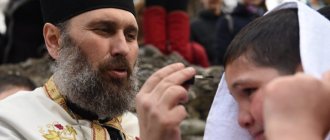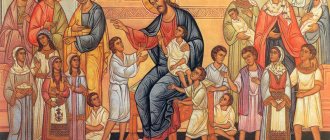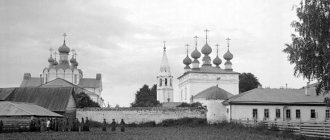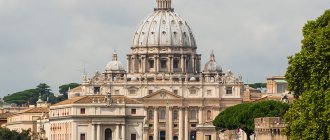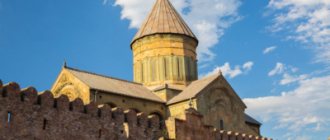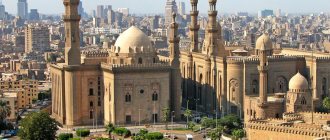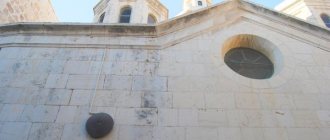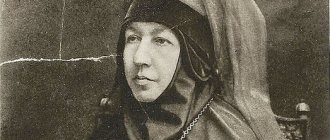Christianity in the North Caucasus: the path through millennia
One of the Zelenchuk churches before restoration
The ancient cathedrals of Kyiv, Moscow, Pskov, Suzdal, the baptism of Rus' under Prince Vladimir, the life and works of ancient saints... - all these are Christian antiquities and facts with which our history is traditionally associated. But the land of the North Caucasus also holds great treasures: Alania adopted Christianity before Rus', and the oldest churches in Russia are located in Karachay-Cherkessia.
Christian antiquity of the North Caucasus
When Major General Alexei Yakovlevich Potemkin visited the gorge of the Bolshoy Zelenchuk River in 1802, he was greeted by an amazing sight: the hard-to-guess ruins of an ancient city, half sunk into the ground, with several stone temples in the Greek style, overgrown with trees and bushes...
Nowadays this place in Karachay-Cherkessia is called the Nizhne-Arkhyz settlement. And the temples that survived centuries of oblivion have been partially restored and are known as the Northern Church (presumably Nikolsky), the Middle Church (possibly Preobrazhensky) and the Southern Ilyinsky Church - the oldest functioning church in Russia. According to scientists, religious buildings were built in the 10th century during the establishment of the Alans, the ancestors of the Ossetians, in Christianity. The Sentinsky and Shoaninsky temples of Karachay-Cherkessia, picturesquely located on the tops of small mountain ranges (they can be seen by travelers heading to the resorts of Arkhyz and Dombay), belong to the same era.
The Elijah Church in Arkhyz is perhaps the oldest functioning temple in Russia.
Under Patriarch Nicholas the Mystic of Constantinople (ruled the Church in 901-907 and 912-925), relations between the Roman kingdom (Byzantium) and Alania developed rapidly. By that time, the Alans had been neighbors with Christian peoples for many centuries: Greeks, Georgians, Armenians. Cultural and religious influence, coupled with the political power of Byzantium, led to the fact that the Alan nobility decided to conclude a strategic alliance with the Kingdom of Rome. It was then (between 916 and 925) that the event known as the great baptism of Alanya took place. A diocese was formed, the center of which was the current Nizhne-Arkhyz settlement (the residence of the archbishop was located there). The creation of Alan writing based on the Greek alphabet dates back to approximately the same era (the so-called Zelenchuk inscription on a tombstone cross of the 11th century is known).
Middle Zelenchuk Temple
However, the history of Christianity in the North Caucasus goes back to even more ancient times. According to church tradition, the holy apostles Andrew and Simon the Canaanite preached on the Caucasian coast of the Black Sea. After the adoption of Orthodoxy in Georgia and Armenia at the beginning of the 4th century, the neighboring North Caucasian peoples learned about Christianity. It is interesting that Saint Grigoris, the grandson of Equal-to-the-Apostles Gregory the Illuminator, suffered martyrdom in the 4th century not far from the Dagestan Derbent (in 1916 an Armenian temple was erected in memory of this).
Northern Zelenchuksky Temple
The 6th century saw another surge in the missionary activity of the Byzantines, when under Emperor Justinian the Great many peoples of the Adyghe group adopted Christianity. As the Kabardian scientist and poet Shora Nogmov (1794-1844) wrote, “... under the influence of the alliance with Justinian, the Greek clergy, penetrating the Caucasus Mountains, brought to us the peaceful pursuit of art and education. (...) The Christian faith flourished in the Caucasus Mountains, supported by the Greek clergy.” More than a thousand years after Justinian, the German scientist Peter Simon Pallas, who visited the North Caucasus (particularly Kabarda) in 1793-1794, encountered many traces of the ancient Christianity of the Circassians. He wrote: “From the many old ruins found here, one can judge that these Chegems were previously more numerous when they adhered to the Christian religion. Indeed, they still have churches, one of which is located on the banks of the Chegem and is quite remarkable (...). In this church there are still fragments of books, several pages of which I obtained by sending one person on this dangerous enterprise. One of the sheets contains part of the Gospel in ancient Greek; others turned out to be scattered parts of books used in the Greek liturgy.”
Historical sources reliably indicate that in the 7th century there were communities of Alans - Christians and even an Alan ruler named Gregory. By the way, it was then that an Orthodox saint, St. Maxim the Confessor, found himself in exile in the Caucasus (according to one version, he visited the area of the current village of Khumara in Karachay-Cherkessia).
In the 9th century, the famous Thessalonica brothers, Saints Cyril and Methodius, visited the North Caucasus on their way to Khazaria.
Sentinsky Temple
The Christian enlightenment of the North Caucasus was not limited only to Alania and the lands of the Circassians, it also affected the Vainakhs and the peoples of Dagestan. Here, in the Eastern Caucasus, Georgian missionaries mainly worked. According to some information, Christianity has been spreading among the Vainakhs (the ancestors of the Chechens and Ingush) since the 7th century (by the way, a group of Orthodox Vainakhs, the Batsbis, still lives in Georgia). Monuments of that activity are the strict and severe in their architecture temples of Albi-Erda (VII-X centuries) and Thaba-Erda (VIII-XII centuries) in Ingushetia. Thaba-Erdy remained a popular cult center even in Islamic times.
Thaba-Erdy
In mountainous Dagestan in the 10th-13th centuries there was a Christian state entity - Serir. The Datun Temple (X-XI centuries), many stone crosses and monuments of ancient Georgian writing have been preserved.
However, in the 13th century, after the invasion of the Mongols and Tamerlane in the 14th century, as well as the fall of Constantinople in 1453 under the attacks of the Ottoman Turks, Christianity in the North Caucasus fell into decline. Rus' was still gaining strength, Byzantium ceased to exist, and Georgia was exhausted in the struggle for its survival. It seemed that Christianity in the North Caucasus had died out forever.
Datong Temple
Restoration of Christianity in the North Caucasus
In the 16th century, Russia began to advance to the Caucasus. The fortress (fortress) Terki was founded on the Terek. In 1586, the ruler of Georgian Kakheti, Alexander, turned to the Russian Tsar Fyodor Ivanovich for protection. And in 1650, the king of Imereti, Alexander, recognized the power of the Moscow sovereign over himself.
During the 17th-19th centuries, there was a long, difficult, full of contradictions, but still irreversible and beneficial assertion of Russia in the North Caucasus, which had the tasks of uniting with Georgia of the same faith, pacifying the borders and ousting the then main enemy - Turkey. An integral component of this great process was the revival of Christianity; traces of it by that time were preserved only among the Ossetians, whose noble representatives, entering the service of Russia, as a rule, converted to Orthodoxy. In 1787, Kurman Kubatiev was baptized; his successor (godmother) was the Empress Catherine II herself.
Armenian Church of St. Grigoris in Dagestan
An important milestone was the founding in 1860 of the Society for the Restoration of Orthodox Christianity in the Caucasus, which was headed by the Viceroy of the Caucasus, Prince Alexander Ivanovich Baryatinsky, and then by Grand Duke Mikhail Nikolaevich Romanov. The corresponding imperial decree stated that in ancient times the Orthodox faith prevailed in the Caucasus, and “in the mountains many remnants of the former, but not yet extinguished, light of Christianity are still preserved.” One of the first Ossetian enlighteners, priest Akso Koliev, expressed himself in a similar way: “Everything religious that I had hitherto encountered in Ossetia filled me with compassion, I saw remnants of the orthodox confession everywhere. But, alas, distorted!”
Monument to priest Akso Koliev in Vladikavkaz
In the middle of the 19th century, a galaxy of outstanding educators emerged: in addition to Koliev, these were Bishop Joseph (Chepigovsky) of Vladikavkaz, priests Mikhail Sukhiev, Alexy Gatuev and others. The Ossetian Church of Vladikavkaz became the most important educational center. As a result, many ancient desecrated temples were restored and new ones were built. Dozens of schools were founded in which both boys and girls studied. The latter was an innovation in the conditions of that time and taking into account the specifics of the Caucasus. By 1880, there were seven girls' schools, where about two hundred girls studied, many of whom later became teachers and brought literacy to new generations of Ossetians.
Memorial plaque to the “Apostle of Ossetia” Bishop Joseph in the Novospassky Monastery in Moscow
A great contribution was made to the development of Ossetian culture. Akso Koliev became the founder of modern Ossetian poetry, and Bishop Joseph, together with Ossetian priests, compiled the Ossetian alphabet (based on Russian) and published many books in the Ossetian language.
And this is only a small part of the enormous educational work that was carried out in Ossetia and other regions. Its result was that the ancient roots of Christian civilization in the North Caucasus sprouted new shoots.
Cathedral of the Pyatigorsk and Circassian diocese in Pyatigorsk
After a series of conflicts, a path was found for the peaceful coexistence of different cultures and religious traditions. In the 10th century, the Arab traveler Ibn Haukal described the situation in Dagestan as follows: “... the people of Serir are Christians. There is peace between the people of Serir and the Muslims.”
I would like to see peace between Christians and Muslims strengthened in our time.
Project of the Church of St. Alexander Nevsky in North Ossetia
The North Caucasus is a sacred place in Russia
Undoubtedly, the North Caucasus is one of the sacred centers of Russia. And not only for Christians. Suffice it to mention that Derbent has one of the oldest mosques in the world, built in the 8th century.
As Archbishop Theophylact of Pyatigorsk and Circassia said: “The Caucasus is an ancient Christian land, baptized long before Rus'. This is a blessed land where God has given us everything we need for an abundant life. (...) The Caucasian house was built over thousands of years, and different ethnic groups always lived in it, professing different faiths, which did not bother anyone.”
Monumental image of our Lord Jesus Christ in Essentuki
On October 14, 2021, President Vladimir Putin signed a decree to celebrate the 1100th anniversary of the baptism of Alanya in 2022.
As in the Crimean Chersonese, modern Russia in the Caucasus recognizes its sacred roots in order to, preserving state unity and centuries-old traditions, carry them through the next century of our difficult history...
Social and political magazine "Men's Work".
Evidence of the Ancients
Finding out the origin of the Udins is quite difficult. In terms of language, they are a nationality of the Nakh-Dagestan family of the Lezgin group, considered a direct descendant of the population of ancient Caucasian Albania. In ancient times they had a writing system based on the Armenian alphabet, but it is now lost. Scientists are still scratching their heads on the issue of the genetic origin of the Udis. Some refer to the writings of Herodotus (5th century BC), who mentioned the “Utii,” a people within the Persian Empire.
In the “Natural History” of Pliny the Elder (1st century AD), certain “Udini” are mentioned who lived on the shores of the Caspian Sea, not far from Caucasian Albania. At the same time, the ancient Roman historian calls this people Scythian, although the Udin language contains very few borrowings from Iranian dialects. Let us pay attention to the region of Caucasian Albania. Greco-Roman historians called it Otena or Utik, which is similar to the word “udini”. Strabo wrote that the Albanians in the Caucasus are divided into 26 tribes that do not understand each other well. Perhaps the Udins were one of the nationalities of this ancient state that escaped complete assimilation?
Tolkalina's daughter has changed greatly. How Maria ate to lose 30 kg
Photo gallery of Soviet actors who brilliantly played generals in films
The company already has electric vehicles, next in line are hydrogen vehicles: KAMAZ
Udins in our time
Despite the fact that the small people lived surrounded by Muslim neighbors, they managed to preserve their genetic, cultural and religious identity. According to the 2010 population census, 4,127 Udis now live on the territory of the Russian Federation. A compact group (1866 people) inhabits the Rostov region. The rest are scattered across other regions of the North Caucasus.
In addition to Russia, Udins live in Ukraine, Kazakhstan, Armenia and Georgia. During the years of the Soviet Union, a large community inhabited Azerbaijan. After 1989, as a result of ethnic cleansing, many members of the ethnic group fled, mainly to Armenia. But even now, in the north of Azerbaijan, in the village of Nij, Gabala region, there remains a compact settlement of Udis with a population of 3,800 people.
Found a violation? Report content
Christianity in Caucasian Albania. Church tradition
If all statements about the genetic origin of the Udis are just scientific hypotheses, then the evangelization of the region is already proven facts. Although here too there were some church traditions. According to them, the baptizer of the North Caucasus was the disciple of the Apostle Judas Thaddeus Elisha. He was ordained by Christ's brother James himself, after which he went to bring the Word of God to the country of Utik. In the city of Gis he built the first Christian temple. Scientists identify this same Ghis with Kish (now a village in the Sheki region in Azerbaijan).
And indeed, at the beginning of the twentieth century this village was inhabited by Udins. A Christian church from the 12th century is still preserved there, now turned into a museum. The Baptist Elisha is revered only among the Udins. Even the Armenian-Gregorian Church, of which representatives of a small nation consider themselves a part, did not canonize him.
